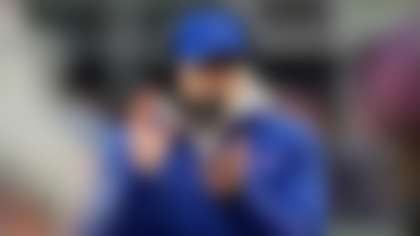NFL HEALTH AND SAFETY UPDATE -- OCTOBER 23, 2013
Q&A WITH HEAD, NECK AND SPINE COMMITTEE MEMBER STANLEY HERRING
Dr. Stanley A. Herring has served as a Seahawks team physician for over 20 years. He also chairs the NFL Head, Neck and Spine Committee's Subcommittee on Advocacy and Education. He recently answered questions about concussion management and the introduction of sideline concussion assessment software, accessible via tablet.
What is the process for establishing a baseline score for players?
Attention to concussion takes place not only on the field, but also before an injury ever takes place. Prior to the start of the season, team medical staffs administer baseline neuropsychological tests and a baseline history and physical examination that focus on areas like orientation, memory, concentration and balance. The baseline history and physical examination results are recorded via a sophisticated software program. The baseline history and physical examination test uses a 0 to 6 scoring system to rate symptoms such as headache, fatigue and dizziness. A total of 22 symptoms are rated. It also includes orientation questions (e.g. "What is today's date? What day of the week is it?") short- and long-term memory tests (e.g. recalling a list of words), concentration tests (e.g. reciting a string of numbers backward). There's also a part of the test in which the player must perform certain physical tasks, like standing on one leg to assess balance.
Why is baseline testing important? And why is it helpful to have test scores available in tablet form?
The baseline scoring system helps determine if there are large discrepancies between a player's baseline score and his score if there is a suspected concussion during a practice or game. The tablet software, created by X2 Biosystems, allows medical staff to access any given player's results on the sideline or locker room and simultaneously compare his baseline scores to practice or game day scores. The software allows for baseline results to be portable, storable and transferrable, which is helpful in concussion diagnosis and management. Previously, team medical staff needed to bring paperwork to the sideline or locker room and consult baseline paperwork if a suspected concussion occurred. In addition, now the baseline data and any data obtained after a possible concussion stays with the player in the event he switches teams.
How did use of the tablet and app come about?
The use of tablets was based on a recommendation from the NFL Head, Neck and Spine Committee. It is an important component of a comprehensive concussion assessment.
HEADS UP FOOTBALL AMBASSADORS VISIT YOUTH LEAGUES
Former NFL players now serving as Heads Up Football Ambassadors spent time with Heads Up youth leagues across the country in recent weeks, reinforcing Heads Up tackling and talking about the values of football participation.
Former New England Patriots linebacker Vernon Crawford worked with Westfield Youth Football players in Westfield, Mass.
"(We're) not just teaching the kids, but also teaching the parents and the coaches, that everybody is all aware, and that we all are as one." Crawford said. "Everybody is communicating, including the parents, about how their kids are acting on the field. (If someone) is totally out of character, the coach should notice it, everybody should notice it. Those are the big parts of (Heads Up Football)."
Ricardo McDonald, a former linebacker for the Chicago Bears and Cincinnati Bengals, went to a Cy-Fair Sports Association game at Kahla Middle School in Houston, Texas, where he spoke about the importance of Heads Up Football.
"To me, this is the most important initiative we have as a league because it's all about these young people and it's all about making sure that our game continues to be promoted the safe way that you play it," McDonald said. "Football is such a wonderful part of life that teaches young people so much. It's important and that's why our organization is as supportive as it is and that's why the NFL is as supportive as it is."
Mike Meade, a former running back for the Detroit Lions and Green Bay Packers, visited the Middletown Odessa Townsend Youth Football & Cheerleading League for practice in Middletown, Del. Meade spent time with players as they participated in drills, encouraging them to listen to their coaches and practice proper tackling techniques.
"This is a great game and it really prepares you for life, but if a kid has a bad experience early or gets hurt, they're likely to give up on the sport and go play something else," Meade said. "(Heads Up Football) is about keeping kids safe and getting them to develop good habits early, but it's also about preserving and growing the popularity of the game."
Former Seattle Seahawks defensive tackle Craig Terrill watched the CD Panthers play in Seattle, Wash., after attending a practice for the league the week before.
"It's a physical sport, you're going to get bumps and bruises," said Terrill, "but the important thing is protecting your head from concussions."
Other Heads Up Football Ambassadors visiting youth leagues in October include: Buddy Curry, Al Del Greco, Troy Drayton, Keith Elias, Justin Green, Al Gross, Arlen Harris, Aaron Hayden, Gary Howe, Brian Kinchen, Drew Mahalic, Eugene Robinson, Karl Swanke and Coy Wire.
-- NFL Communications


